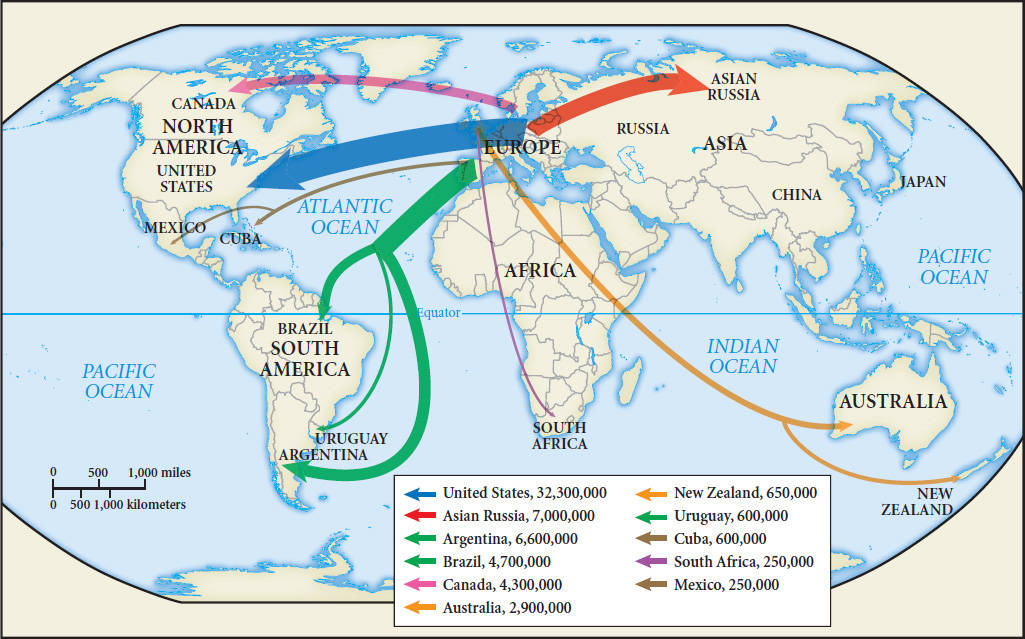Europeans in Motion
Europe’s industrial revolution prompted a massive migratory process that uprooted many millions, setting them in motion both internally and around the globe. Within Europe itself, the movement of men, women, and families from the countryside to the cities involved half or more of the region’s people by the mid-nineteenth century. More significant for world history was the exodus between 1815 and 1939 of fully 20 percent of Europe’s population, some 50 to 55 million people, who left home for the Americas, Australia, New Zealand, South Africa, and elsewhere (see Map 17.2). They were pushed by a rapidly growing population, poverty, and the displacement of peasant farming and artisan manufacturing. And they were pulled abroad by the enormous demand for labor overseas, the ready availability of land in some places, and the relatively cheap transportation of railroads and steamships. But not all found a satisfactory life in their new homes, and perhaps 7 million returned to Europe.26

This huge process had a transformative global impact, temporarily increasing Europe’s share of the world’s population and scattering Europeans around the world. In 1800, less than 1 percent of the total world population consisted of overseas Europeans and their descendants; by 1930, they represented 11 percent.27 In particular regions, the impact was profound. Australia and New Zealand became settler colonies, outposts of European civilization in the South Pacific that overwhelmed their native populations. Smaller numbers found their way to South Africa, Kenya, Rhodesia, Algeria, and elsewhere, where they injected a sharp racial divide into those colonized territories.
But it was the Americas that felt the brunt of this huge movement of people. Latin America received about 20 percent of the European migratory stream, mostly from Italy, Spain, and Portugal, with Argentina and Brazil accounting for some 80 percent of those immigrants. Considered “white,” they enhanced the social weight of the European element in those countries and thus enjoyed economic advantages over the mixed-race, Indian, and African populations.
In several ways the immigrant experience in the United States was distinctive. It was far larger and more diverse than elsewhere, with some 30 million newcomers arriving from all over Europe between 1820 and 1930. Furthermore, the United States offered affordable land to many and industrial jobs to many more, neither of which was widely available in Latin America. And the United States was unique in turning the immigrant experience into a national myth—that of the melting pot. Despite this ideology of assimilation, the earlier immigrants, mostly Protestants from Britain and Germany, were anything but welcoming to those who arrived later as Catholics and Jews from Southern and Eastern Europe. The newcomers were seen as distinctly inferior, even “un-American,” and blamed for crime, labor unrest, and socialist ideas.
In the vast domains of the Russian Empire, a parallel process of European migration likewise unfolded. After the freeing of the serfs in 1861, some 10 million or more Russians and Ukrainians migrated to Siberia where they soon overwhelmed the native population of the region. By the end of the century, native Siberians totaled only 10 percent of the population. The availability of land, the prospect of greater freedom from tsarist restrictions and from the exploitation of aristocratic landowners, and the construction of the trans-Siberian railroad—all of this facilitated the continued Europeanization of Siberia. As in the United States, the Russian government encouraged and aided this process, hoping to forestall Chinese pressures in the region and relieve growing population pressures in the more densely settled western lands of the empire.